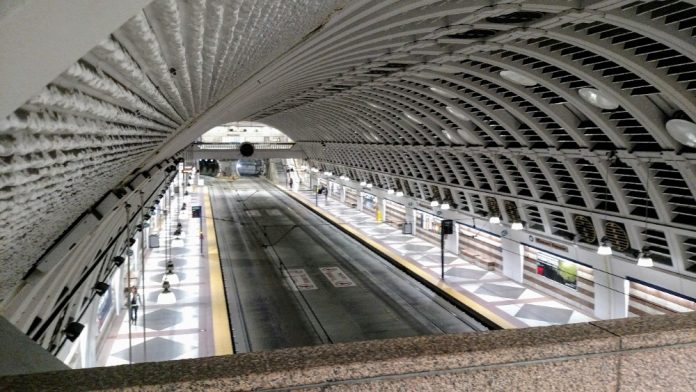It was a busy week at Sound Transit headquarters. Agency staff briefed regional policymakers on a range of topics from Connect 2020 progress to equitable transit-oriented development, but perhaps most interesting was station renaming and an update on the fare enforcement policy evaluation process. The Sound Transit Board of Directors’ Rider Experience and Operations and Executive Committees convened on Thursday to receive the marathon of reports and took action to move forward with renaming University Street Station.
Renaming University Street Station
As has been widely discussed in the past year, University Street Station (USS) is in need of a new name to reduce confusion with two other “university” stations in the light rail system. Sound Transit inherited US from King County Metro which had owned and operated the underground station exclusively for buses nearly two decades until Link light rail service was introduced in 2009.
Then in 2015, light rail was extended north of the Montlake Cut on the footsteps of the University of Washington campus. Naturally, the station there became “University of Washington Station.” When the Light rail system expands again in 2021, one of the new stations on Central Link will be “U District Station”. Sound Transit tried to reduce confusion with the “U” in the name, but everyone knows it as the “University District”. Thus, a change of names is warranted to achieve the stated objectives of the system station naming policy.

In the fall, Sound Transit surveyed the public on six shortlisted station names, which included the Arts District, Benaroya Hall, Downtown Arts District, Midtown, Seneca Street, and Symphony. These naming options were chosen because they reflect different attributes of the area, such as literal adjacent street, the city symphony hall and artistic venues, and geography. Over 14,000 people participated in the station naming contest, which led to a very narrow plurality victory for Symphony Station.

Symphony Station beat out Benaroya Hall by only 0.39%, reaching 24.89% of the vote. Agency staff recommended this name with caveat that it include Union Street in it, making it Union Street/Symphony Station. The rationale for this is to reduce backend costs and ensure that emergency professionals will be sent to the correct station.
For years, Sound Transit has referred to University Street Station as “USS” and has built electronic systems upon this code. Staff also use the code in common parlance as do external emergency professionals familiar with the station. Picking only Symphony Station or “SS” would be more costly and risky, agency staff said. Implementation cost for station renaming is pegged at $5.3 million if just Symphony Station is ultimately chosen, in large part due to those backend costs. Choosing Union Street/Symphony Station, however, would save over $4 million in implementation costs. That is because the bulk of the cost would be just in replacing signage rather than also updating backend systems.
However, the station does not have direct access to Union Street. The station entrance front onto Third Avenue, University Street, Second Avenue, and Second Avenue. With no Union Street access, the name could wind up being a bit of a misnomer. Nevertheless, the Rider Experience and Operations Committee supported the recommended Union Street/Symphony Station, sending it forward to full board for consideration and final action later this month. (Update: On January 23rd, the Sound Transit Board of Directors adopted the Union Street/Symphony Station name, which will go into effect when the Northgate Link extension opens.)
Fare enforcement policy evaluation
No action was taken to reform fare enforcement policies, but agency staff did walk through the progress that has been made in determining possible policy changes. Sound Transit has been directly engaging customers on their perspectives of fare enforcement and coordinating through an interdepartmental workgroup to devise policy options. Several overarching goals are informing the evaluation process, such as racial equity, rider safety, fare evasion rates, community support, and cost of implementation. Agency staff did caution that entirely eliminating fares and eliminating fare enforcement are non-starters since such policies could affect the financial stability of the organization and drive down fare payment compliance.
For context, Sound Transit uses fare enforcement on its Central Link light rail and Sounder commuter rail services. Within a 12-month period, any rider caught without valid fare media the first time is given a warning and entered into the database. Second-time and additional violations during a 12-month period are issued a civil citation. Each citation comes with a $124, which goes entirely to the court with jurisdiction. Criminal charges for non-payment are currently suspended while the fare enforcement policy is being reevaluated.
A variety of policy options are being considered, many of which King County Metro has implemented in the past two years. Agency staff highlighted about a dozen different strategies. First among these are expanding the use of ORCA LIFT–a low-income fare program–by riders, reducing the look-back period for initial warnings from 12 months to six months, reducing the cost of fines, and creating options to further reduce fines and alternative resolution methods for second-time violations during the look-back period.
For second-time violations, fines might be avoided if the cited rider agrees to do community service for a local nonprofit organization or enrolls in the ORCA LIFT program. The latter option would only be available to riders who qualify for ORCA LIFT. Another option for second-time violations would be for riders to put an equivalent dollar amount on their ORCA cards to what the fine would normally be.
In tandem with this, Sound Transit is intent on improving rider awareness of valid fare media. That means the transit agency will retool its communications and marketing approaches in educating riders on options to obtain and use it.
Another set of policies under review could modify how fare enforcement officers interact with riders. One big change under consideration would bring fare enforcement officers in-house instead of using contract staff to carry out fare enforcement. That would bring the chain of command under closer agency control. Fare enforcement could also move off-board trains so as to be conducted on platforms–which are fare-paid zones–in order to make the process less disruptive and painful to riders. Several other possible fare enfocement officer-specific changes include prioritizing customer service, changing uniforms to feel more customer friendly, and updating training and protocols related to anti-bias and de-escalation.

Several new options are also being considered, particularly focused around youth riders, transfers, and suspension of inspections.
Heavy criticism was levelled against the transit agency when warnings were given out to students on their first day of classes in the fall. But these new options could prevent similar circumstances from happening in the future. Options on the table include establishment of alternative procedures for youth riders under the age of 18. The type of consequences for non-payment could be different from adults and offer alternative resolutions. Parents might also be notified as part of the procedures. Fare enforcement officers would also receive special training on how to deal with youth interactions.
Transfers could also be overhauled by increasing the length of time that they can be made. Currently, riders are given 90 minutes from their first ORCA tap to make valid transfers and complete their journeys. Another option would be to accept all transfers from other regional transit agency partners, but that certainly could mean lower fare revenues if paper transfers are being used.
Finally, there may be times that Sound Transit deems fare enforcement inspections should be suspended. Agency staff cited severe inclement whether–perhaps as Metro does if the Emergency Snow Network is activated–and the first day of school as possible examples. It is not yet clear how extensively inspection suspension might be used, but major social and athletic events where demand far outpaces capacity may be other warranted instances.
During the Executive Committee meeting, Peter Rogoff, the chief executive officer of Sound Transit, did caution that any changes to fare enforcement policies could affect farefox recovery. Sound Transit collected around $95 million last year and is projected to reach approximately $100 million by the end of year. However, Link is not achieving its fare recovery goal and has not been for some time. Rogoff expressed hoped that those numbers would improve as the Northgate Link extension comes online next year, but if not, a fare increase may be necessary to bridge the difference.
Formal proposals to modify the fare enforcement are still forthcoming. Agency staff indicated that the Sound Transit Board of Directors should expect concrete proposals in March and could take action then, which may require additional budget authority for implementation.
Stephen is a professional urban planner in Puget Sound with a passion for sustainable, livable, and diverse cities. He is especially interested in how policies, regulations, and programs can promote positive outcomes for communities. With stints in great cities like Bellingham and Cork, Stephen currently lives in Seattle. He primarily covers land use and transportation issues and has been with The Urbanist since 2014.




